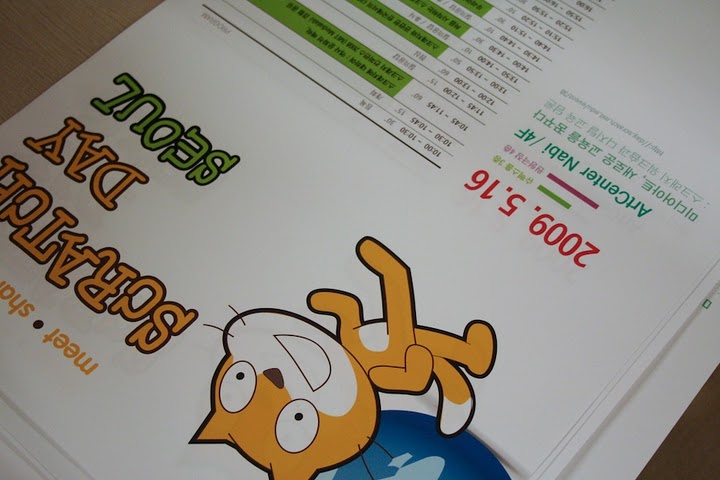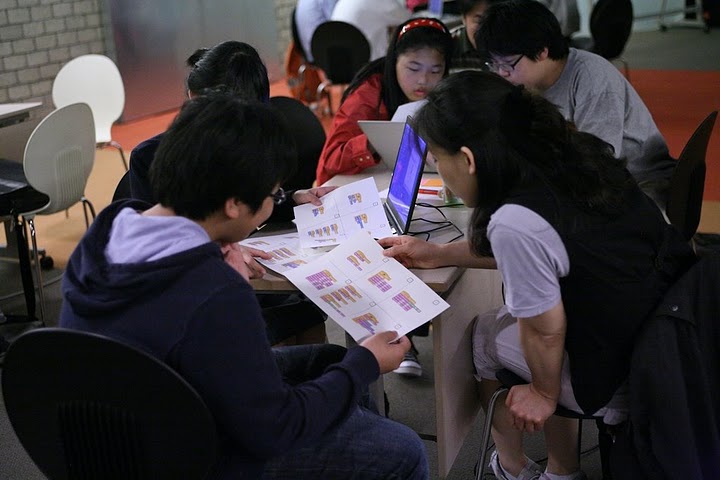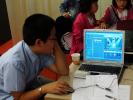Pollination: An Interview with Seung Joon Choi about Scratch Day Seoul
Everyone is their own worst critic. Seung Joon Choi is passionate about education innovation, but when asked about Scratch Day Seoul, he says, “It was quite a success, but not that big of a success.”

Talk to any of the educators, artists, programmers, manufacturers, researchers or parents who attended Scratch Day Seoul and you’ll hear quite a different story. Seung Joon creatively organized a two-tiered workshop with engaging speakers and an interactive immersion into Scratch, adapted from Seung Joon’s curriculum for university students. Participants learn Scratch in groups of three. Each person is assigned a role: the “Driver” works directly on Scratch (with translated Korean blocks), the “Navigator” helps the Driver figure out what to program, and the “Documenter” observes and takes notes. Three iterative rounds titled “Creative, Collaborative, and Exploratory,” run thirty minutes each. Five minutes of demonstration are followed by fifteen minutes of Scratch, during which the teacher remains hands-off. “We are coaches. We don’t instruct. They are supposed to explore Scratch by themselves.” Five minutes of retrospection presented by each group’s Documenter conclude the round. Students proceed to swap roles, and the second cycle begins.

The Documenter in the third, “Exploratory” round acquires an additional task, about which Seung Joon is most excited. In this final cycle, the position of Documenter evolves into “Pollinator, like the role for bees in the flower field. They are encouraged to visit other teams and learn from each other just like bees, transferring over ideas and sharing ideas.” Students contribute ideas, practice communication skills, and build community quickly through this exercise.
Emphasis on community building is also present in the “inner games” that occur in between each round. Learners are asked to rate their satisfaction with the activity from one to ten. “One means ‘I don’t know, I don’t like Scratch, I don’t get anything,’ and ten means ‘Wow, that’s great! I feel like I can do it.’” After each round of Scratch programming, the students repeat the inner game. Participants become increasingly self-aware and start to invest in and consider other students’ feelings. “They talk about, ‘Why is his point six, not seven? How can we improve his point?”

This community-bonding workshop works well in his university courses, but Seung Joon feels that Scratch Day failed to establish strong relationships within the adult Scratch community, thus revealing his disappointment with the event. “I developed some exploratory ways for using Scratch, but not for sustaining the Scratch community of those who are interested in the philosophy that Scratch wants to pursue. I just illustrated some vision, but I couldn’t make the community. As an event, it was a success, but as a building of community, it was not that successful.”

As a media artist and software programmer, Seung Joon is motivated to change the culture of isolation presently inherent in these two industries in South Korea. He was hoping to break the ice with the participants at Scratch Day Seoul. “Designers and artists in Korea don’t have time in school for learning how to discuss or explore. They don’t know each other. During this kind of workshop, they have many chances to know each other and learn from each other. Scratch is good for doing that. If it were another tool, maybe it would not be possible. There would be too many syntax errors or something like that.” Seung Joon believes that having the right technology is crucial, but focuses on relationship. “Although the tool is important, community is more important. There are many people who are interested in media art in Korea.”

A strong sense of responsibility for cultivating a collaborative society of pollinating learners has inspired Seung Joon to build his own beehive. Co-founder of a charter elementary school near Seoul, his kindergarten class practices “unplugged computer science.” Young learners draw pixel art on grid paper and quickly progress to writing simple commands for partners to follow. Seung Joon declares that his motivation for starting the school was “to make my village a more creative village, a more creative society, a cultural hub,” and says that his main goal in educating these young pollinators is “to maybe help them in my small way.”






